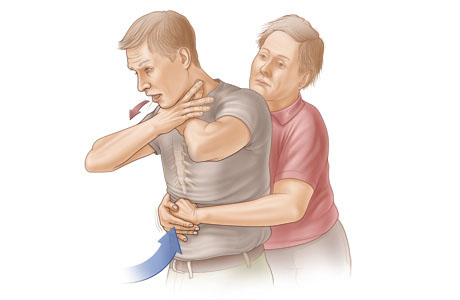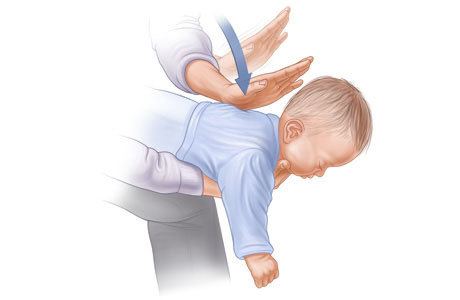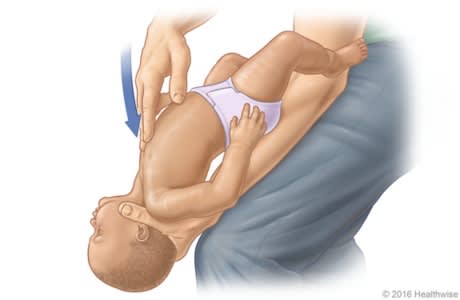Women’s Health Library
Our Health Library information does not replace the advice of a doctor. Please be advised that this information is made available to assist our patients to learn more about their health. Our providers may not see and/or treat all topics found herein.
Choking Rescue Procedure: Heimlich Maneuver
Overview
A person who is choking (whose airway is completely blocked by food or an object):
- Can't cry, talk, breathe, or cough.
- May grasp their throat.
- May become severely anxious or agitated.
- May turn blue or dusky in color.
- May pass out.
A choking rescue procedure (the Heimlich maneuver) is used to clear an obstruction in adults and children older than 1 year. Back blows and chest thrusts are used in babies younger than 1 year.
Health Tools
Health Tools help you make wise health decisions or take action to improve your health.
Adult or Child Older Than 1 Year
A person who is choking cannot talk, cough, or breathe, and may turn gray or blue. The Heimlich maneuver can help get the food or object out. WARNING: Do not try the Heimlich maneuver unless you are sure the person is choking.
If the person can cough or make sounds, let the person cough to try to get the object out. If you are worried about the person's breathing, call 911.

If the person can't breathe, cough, or make sounds, then:
- Stand or kneel behind the person and wrap your arms around their waist. If the person is standing, place one of your legs between their legs so you can support the person if they faint.
- Make a fist with one hand. Place the thumb side of your fist against the person's belly, just above the belly button but well below the breastbone.
- Grasp your fist with the other hand. Give a quick upward thrust into the belly. This may cause the object to pop out. You may need to use more force for a large person and less for a child or small adult.
- Repeat thrusts until the object pops out or the person faints.
Person Faints
Call 911 or other emergency services if the person faints. Then:
- Start CPR (cardiopulmonary resuscitation) if you know how.
- If you do rescue breaths, look for an object in the mouth or throat each time the airway is opened during CPR. If you see an object, remove it.
- Do not do any more Heimlich thrusts.
- Keep doing CPR until the person is breathing on their own or until help arrives.
Learn more
Choking While Alone
If you choke while you are alone, use your fists to do thrusts on yourself. Or lean over the back of a chair and press hard to pop out the object.
Baby (Younger Than 1 Year)
If the baby can cough or make sounds, let the baby cough to try to get the object out. If you are worried about the baby's breathing, call 911.
WARNING: Do not begin the choking rescue procedure unless you are certain that the baby is choking.


If a baby can't breathe, cough, or make sounds, then:
- Put the baby facedown on your forearm so their head is lower than the their chest.
- Support the baby's head in your palm, against your thigh. Don't cover their mouth or twist their neck.
- Use the heel of one hand to give up to 5 back slaps between the baby's shoulder blades.
- If the object does not pop out, support the baby's head and turn the baby faceup on your thigh. Keep the baby's head lower than their body.
- Place 2 or 3 fingers just below the nipple line on the baby's breastbone and give 5 quick chest thrusts (same position as chest compressions in CPR for a baby).
- Keep giving 5 back slaps and 5 chest thrusts until the object comes out or the baby faints.
-
If the baby faints, call
911 (if you haven't called already). Then:
- Do not do any more back slaps or chest thrusts.
- Start CPR. If you do rescue breaths, look for an object in the mouth or throat each time the airway is opened during CPR. If you see the object, take it out. But if you can't see the object, don't stick your finger down the baby's throat to feel for it.
- Keep doing CPR until the baby is breathing on their own or until help arrives.
Learn more
Related Information
Credits
Current as of: October 1, 2025
Author: Ignite Healthwise, LLC Staff
Clinical Review Board
All Ignite Healthwise, LLC education is reviewed by a team that includes physicians, nurses, advanced practitioners, registered dieticians, and other healthcare professionals.
Current as of: October 1, 2025
Author: Ignite Healthwise, LLC Staff
Clinical Review Board
All Ignite Healthwise, LLC education is reviewed by a team that includes physicians, nurses, advanced practitioners, registered dieticians, and other healthcare professionals.
This information does not replace the advice of a doctor. Ignite Healthwise, LLC disclaims any warranty or liability for your use of this information. Your use of this information means that you agree to the Terms of Use and Privacy Policy. Learn how we develop our content.
To learn more about Ignite Healthwise, LLC, visit webmdignite.com.
© 2024-2025 Ignite Healthwise, LLC.






